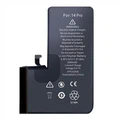Every year Apple has a surprise or two in store for its device lineup, and for 2022 one of those twists is the iPhone 14 Plus. That's because instead of continuing to make a mini version of the basic iPhone, Apple has finally created a more affordable big-screen option starting at $899 for anyone who doesn't need or want to shell out for a $1,099 iPhone 14 Pro Max.
The basics
Packing a 6.7-inch OLED screen with a 2778 x 1284 resolution, the iPhone 14 Plus is the same size as the Pro Max, but with a much lighter body (203 grams vs 240 grams). In fact, due to things like its triple rear cameras and heavy stainless steel frame, the iPhone 14 Pro actually weighs a tiny bit more (206 grams) than the 14 Plus, despite having a significantly smaller screen.
The iPhone 14 Plus has the same basic features as the standard iPhone 14. You get a more playful selection of colors (blue, purple, midnight, starlight and red) than the Pro line, but lose out on some more sophisticated tech such as Apple's Dynamic Island, the new A16 Bionic chip or a dedicated telephoto camera. Instead, you get an A15 Bionic processor (the same as last year's models), just two rear cameras (including the 12MP main sensor from the iPhone 13 Pro), and a new 12MP TrueDepth selfie cam in front.
The phone still feels premium though, and has more than enough performance to handle anything you can throw at it. And as another perk for all the butterfingered folk out there, the iPhone 14 and 14 Plus have a new mid-frame that makes it easier to replace front and back glass panels in the event of an accident.
Just don't try to carry over the physical SIM card from your previous phone, because like the rest of the iPhone 14 line, the Plus only works with eSIMs. This change shouldn't be a huge deal because Apple has supported eSIMs on its phone for years. But for those who haven't made the switch, just remember to save time to contact your carrier in order to convert your physical card into a virtual one.
Display
The most obvious advantage of the iPhone 14 Plus’ increased dimensions is its ability to fit a bigger screen, and over the course of about a week, using it has been a delight. When displaying HDR content, Apple says peak brightness can go as high as 1,200 nits. Meanwhile, using a light meter, I found that our review unit actually exceeded its claimed typical brightness of 800 nits, hitting just shy of 825 nits. And because it's an OLED panel, you get superb contrast and bright colors.






